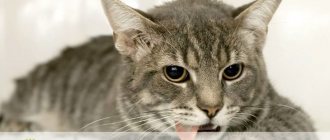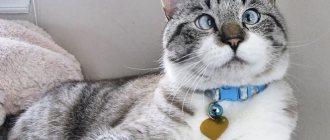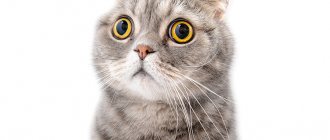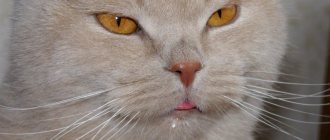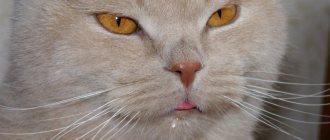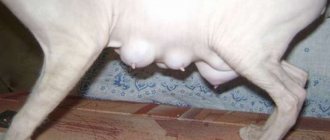Cat's vomit is yellow
Almost all owners panic when their cats vomit yellow liquid. But you need to pull yourself together and observe how often this happens.
If yellow vomit occurs once and there are no other symptoms, a visit to the veterinarian is not required. However, if a cat vomits yellow liquid for several hours or days, he needs to be seen by a specialist immediately - this indicates the accumulation of too much bile in the stomach.
In a kitten, vomiting yellow liquid usually occurs in the presence of congenital pathologies of the digestive organs. This condition requires immediate medical attention. After all, the smaller the kitten, the higher the likelihood of its death due to dehydration. Babies older than 3 months have a higher survival rate in this situation.
Important! Bile can eat away at the stomach lining. Its prolonged accumulation in the stomach leads to the development of inflammation of the digestive organs and even the appearance of ulcers.
Causes
Bile gives the yellow color to vomit. The impurity is brightly colored, has a specific odor and is often associated with problems with the liver and choleretic tract. The reflex occurs after eating poor-quality or stale food, as it increases the load on the liver. Antibiotics have a depressing effect on the organ.
Fatty foods cause overload in the gastrointestinal tract and therefore the body tries to get rid of its excess. A cat vomits yellow liquid due to an overdose of medications. The masses may contain mucus or foam.
Fatty food
In order to correctly determine the causes of the condition, you need to collect the following information:
- Time and circumstances of vomiting.
- Frequency and volume of masses.
- Composition, quantity and consistency of vomit.
- Do you still have an appetite and a feeling of thirst?
- Duration of the gag reflex.
- Presence of chronic diseases.
- Was there any vaccination and deworming?
A green color indicates that intestinal contents have entered the stomach. Vomiting with yellow mucus indicates the appearance of erosion on the mucous membranes of the gastrointestinal tract.
The mechanism of the gag reflex
Usually, owners believe that the cat vomited due to coughing. In fact, it is a symptom of vomiting, not a cause. The attack usually proceeds as follows:
- The cat appears to have increased salivation. She worries, constantly licks herself and swallows the saliva that forms.
- Then a cough begins, the animal breathes frequently and deeply, and stretches its head forward.
- The area of the pharynx and abdomen contracts, first fruitless vomiting appears, and then with the contents.
Important! For cats, vomiting every 3-4 days is normal.
Most often, cats vomit when they eat too quickly or eat too much. This often happens when feeding with low-quality industrial feed or with a mixed diet. Vomiting may also appear in the morning if the cat fell asleep hungry the day before.
If vomiting occurs from overeating, you just need to not let your pet eat or drink for 8 hours, and instead of water, offer to lick an ice cube. If a cat systematically vomits due to an incorrectly formulated diet, it needs to be reconsidered.
All long-haired cats also suffer from nausea and vomiting. When licked, the fur enters the stomach, where it gradually rolls into lumps, which cause irritation of the gastrointestinal tract. This is why burping fur should not be a concern. If there is blood, foam or mucus in the vomit, you should immediately contact the clinic.
Possible diseases
Isolated cases of bile vomiting in cats do not require the help of a veterinarian. Most often they occur due to overeating. In this case, it is enough to adjust the pet’s diet.
Repeated attacks with foam and bile indicate the onset of an inflammatory process in the gastrointestinal tract. This could be a stomach ulcer, gastritis, pancreatitis and other diseases. A veterinarian's consultation is required to make a diagnosis.
White vomit is a consequence of prolonged fasting. It occurs due to the reaction of stomach mucus to oxygen. The animal cannot be fed abundantly at once; portions are given frequently and in small quantities.
Yellow vomiting with blood and foam is an alarming symptom. It appears when there is bleeding in the esophagus, intestines or stomach. With an ulcer or tumor, streaks of blood are present in the mass. Scarlet and homogeneous blood appears when the upper gastrointestinal tract is damaged. This condition requires urgent assistance from a veterinarian.
Vomiting hair in cats
Vomiting that shoots out in a strong stream over long distances requires immediate delivery of the cat to the clinic. The symptom occurs when there is intestinal blockage, high intracranial pressure, or brain damage. Doctor's help required.
In kittens, vomiting occurs due to congenital pathologies of the gastrointestinal tract or low-quality mother's milk. The smaller the cub, the less chance of survival. Kittens from two months of age have a better chance of survival.
A fragile body has a high intolerance to drugs.
If vomiting is accompanied by diarrhea, lethargy, loss of appetite, and fever, then this may be a sign of infectious diseases. Urgent consultation with a veterinarian is required.
Causes of yellow vomit in cats
The correct diagnosis largely depends on the reasons why the cat is vomiting yellow liquid. If the owner remembers when the cat vomited for the first time, and how often it happened in the future, this will help in diagnosis.
Reasons why a cat vomits bile:
- Foreign body in the stomach. Often, while playing, kittens accidentally swallow small objects. If the item eaten is very small, it will pass out with the feces without any problems. If it is quite large in size, the cat’s body will begin to actively produce bile to speed up the digestive process. As a result, the cat will begin to feel nauseated, and along with the vomit, it will regurgitate excess bile.
Important! Large objects eaten by a cat cannot be removed by its intestines, so the pet may well experience a blockage in the stomach or esophagus. If you accidentally swallow various objects, it is better to play it safe and take your cat to see a veterinarian.
- A sudden change in diet. Sometimes owners decide to switch their cat to a more nutritious and high-calorie food. If there is a sudden transition, he will vomit yellow liquid with the presence of remnants of undigested food. This is due to the fact that the liver's work slows down in such a situation, as it is not able to digest too much fatty food.
- Worm infestation. Helminthiasis is one of the most common causes of yellow liquid vomiting in cats. The body tries to rid itself of parasites, as in the case of a foreign body. Worms cause serious disturbances in the functioning of the digestive system. As a result, the cat vomits bile and does not eat anything.
Important! Heartworm infection can also be a reason why your cat is vomiting bile.
- Gallbladder diseases. With any abnormalities and pathologies in the functioning of the gallbladder, cats usually vomit yellow liquid with foam and a distinct odor of bile. Sometimes diarrhea mixed with bile and blood appears. In such a situation, you should immediately go to the veterinarian.
- Pregnancy. During pregnancy, all existing diseases in the cat will worsen. Some pregnant cats vomit yellow liquid. This indicates that they have problems with the gallbladder and its ducts.
- Infectious diseases. Vomiting of yellow liquid can be observed in cats with hepatitis, herpes, rhinotracheitis, panleukopenia (feline distemper). In addition to this symptom, weakness, watery diarrhea, and bad breath are observed. A pet can vomit not only after eating, but also on an empty stomach.
- Postoperative period. Sometimes cats may experience complications after various operations. Vomiting of yellow liquid mixed with blood, foam, brown or green mucus appears. The cat becomes inactive, and his health rapidly deteriorates. The animal's nose remains dry and warm, the fur loses its shine and begins to roll into lumps. In case of any postoperative complications, you must show your pet to a doctor who will select the necessary treatment for him.
Symptoms
Vomiting in a cat that is yellow in color, even once, is a reason to contact a veterinarian, as it is a serious symptom indicating a disruption in the functioning of the body.
You should immediately go to the clinic if your pet experiences repeated vomiting with bile and bloody clots, concentrated with mucus. Such symptoms indicate intestinal volvulus, perforation of the stomach by an ulcerative lesion, or the disintegration of a malignant tumor in the area of the intestinal loops.
In case of fountain vomiting (when it is not possible to leave the house with the animal), it is necessary to call a doctor at home. The younger the animal, the higher the risk of dehydration during prolonged bouts of vomiting.
In addition to the fact that the cat is vomiting bile, other characteristic symptoms may be observed:
- breathing problems;
- profuse diarrhea;
- febrile conditions in the animal;
- coma in a cat;
- swelling in the peritoneum;
- sudden weight loss;
- the cat refuses to drink water and does not eat (symptoms indicate intestinal volvulus).
It is problematic to independently identify the cause of what is happening, and prescribing independent treatment is also dangerous for the animal’s life. Any delay in providing qualified assistance to a cat can cost it its life.
When contacting a veterinary hospital, the veterinarian conducts a general clinical examination and collects a detailed medical history. The medical history must indicate what the animal ate on the eve of vomiting and whether there are any chronic diseases.
In some cases, the doctor may only need a clinical examination and history taking. But in the vast majority of cases, serious examinations are required to make an accurate diagnosis. Accurate diagnosis includes:
- ultrasonography;
- radiography of liver structures, gallbladder and intestinal loops;
- computed tomography for suspected tumor processes;
- endoscopy to exclude inflammation in the stomach and duodenum;
- general blood and urine analysis;
- examination of vomit samples.
Associated symptoms
Yellow vomiting in a cat may be accompanied by additional symptoms depending on the cause that led to its appearance:
- the presence of hairballs, food particles, foam in the vomit;
- refusal to eat;
- deterioration in wool quality;
- constipation.
If you are repeatedly vomiting yellow liquid, you should give your cat something to drink as often as possible. If he does not drink on his own, it is recommended to pour liquid into his mouth every half hour to prevent dehydration. There is no need to feed the cat during this period.
Important! It is strictly forbidden to give your cat antiemetic drugs without a doctor's prescription.
If your pet's condition does not improve within a day, you should take him to the veterinarian.
What do we have to do?
When a pet vomits yellow liquid once, it does not need special help. When the cat's condition does not worsen, there are no other symptoms and the vomit does not contain impurities, the animal does not need support.
It is advisable to give the gastrointestinal tract rest for 8 hours. During this period, access to food and water is limited. To quench your thirst, let them lick ice cubes. The cat will not be able to drink a large amount of water in this way and it will not cause a new attack of vomiting.
After eight hours have passed, the pet is given something to drink and the reaction is observed. If he does not feel sick, then they give him lean boiled meat and fish, and liquid porridge. On the second day they give the usual food.
When a cat eats toxic substances or swallows a foreign body, its owner must artificially induce vomiting. There are several ways to do this.
A gentle method is a saline solution. To prepare it, a solution is made at the rate of a tablespoon of table salt per glass of warm water. The mixture is forcibly fed to the pet until vomiting appears.
An infusion of 3% hydrogen peroxide is allowed - 2 teaspoons every 15 minutes. This is done no more than three times. You can try to irritate the root of the tongue yourself. To do this, open the animal's mouth and press the base of the tongue with a finger.
Hydrogen peroxide
Vomiting should not be induced:
- when the cat is unconscious;
- with seizures and convulsions;
- in case of poisoning with acids or alkalis;
- if it is unknown what object was swallowed.
If a cat burps yellow liquid, then its body is infected with helminths. In this case, it is necessary to submit feces for analysis. If infection is confirmed, the veterinarian will prescribe special medications.
If the feeding regimen is incorrect, treatment at home is acceptable. To do this, use activated carbon or Smecta. The drugs are calculated in the amount of 1 tablet/1 ml per 1 kg of animal weight. A strong mint decoction has an anti-inflammatory effect.
When you need to see a doctor urgently
Sometimes a cat develops symptoms that signal that the animal requires immediate professional help:
- Frequent vomiting that lasts more than 5–10 hours. If your cat has vomited more than once and is constantly thirsty, she most likely has kidney problems.
- Temperature increase.
- Weakness and apathy.
- Very unpleasant smell of vomit and the same smell from the mouth.
- Diarrhea.
- Convulsions or fainting.
- Presence of blood or mucus in the vomit.
- Refusal of water and food. If your cat is vomiting but refuses to eat and loses weight, you may have lipidosis. With this pathology, too much fat accumulates in the liver area. As a result, the functioning of most organs is disrupted, and toxins accumulate in the body itself. A cat showing signs of lipidosis must be hospitalized as soon as possible, otherwise it will die.
- Fountain vomiting.
- Darkening of urine.
- Yellowness of the mucous membranes.
- Problems with passing urine. Sometimes, when vomiting and increased thirst, cats practically do not go to the toilet. This most often occurs when the animal's urinary tract is blocked by stones or worms. In such a situation, urgent surgical intervention will save the cat from death.
Why does my cat vomit yellow liquid?
Vomiting in a cat is a protective mechanism whose task is to cleanse the body of foreign substances. Pet owners cannot always determine the root cause of yellow vomit on their own. Therefore, in most cases it is advisable to contact a specialized specialist.
Malnutrition or, conversely, overeating can disrupt the digestive process of an animal. For example, if a cat falls asleep hungry, its stomach is empty all night - in this case, there is a high probability of morning vomiting. A full stomach can occur due to the consumption of large amounts of food. Then the food simply will not enter the intestines and will travel in the other direction. In addition, food poisoning is a common cause of vomiting.
In some cases, vomiting is accompanied by severe discomfort in the animal. This may be caused by ingestion of a foreign object. If it is small, it will come out in the feces. But with large dimensions of the object, active production of bile acids in the stomach will begin. Vomiting of yellow foam often occurs after excessively sudden changes in diet, with a sharp increase in caloric content of food. The cat's liver may not respond immediately to other feeding conditions. As a result, undigested food and yellow liquid will be observed in the vomit.
Vomiting with bile can also be caused by the presence of helminths. This is how the body tries to get rid of the presence of worms. Yellow vomiting is not uncommon in chronic diseases of the liver, gallbladder, and intestines. The negative impact of infectious pathological diseases and the penetration of foreign viruses or bacteria also affects. As a result, the animal’s liver will actively cleanse the body of toxic substances. The most common and dangerous cause of vomiting is considered to be feline distemper or panleukopenia.
Yellow foamy liquid signals the development of various ailments. However, it is important to take into account additional symptoms that accompany vomiting. With hepatitis, the cat's body temperature rises, appetite decreases, urine darkens, diarrhea and yellowness of the mucous membranes occur. If vomiting yellow liquid has a sharp, unpleasant odor, this may indicate liver failure. Moreover, this is how not only the acute, but also the chronic form of the disease manifests itself. An unpleasant odor from the mouth, frequent fainting, yellowing of the sclera, nausea are signs of the development of serious pathological processes in the liver.
Vomiting yellow foam is a symptom of lipidosis, which is also accompanied by rapid exhaustion of the animal, accumulation of toxic substances directly in the liver, and complete loss of appetite. With feline distemper, the temperature rises sharply to high levels, and the pet becomes apathetic. He is haunted by frequent vomiting, diarrhea accompanied by a pungent odor, and the disease is also indicated by a hunched posture, lack of thirst and appetite.
Of course, it is unacceptable to ignore such manifestations. Only timely medical intervention will help avoid many unpleasant complications.
Diagnostic measures
In a veterinary clinic, if a yellow liquid is vomiting, the doctor will carefully examine the cat, palpate its stomach, check its mucous membranes and measure its body temperature. Next, he will need detailed information about the cat’s condition, as well as documents with notes on vaccination, deworming and previous diseases.
To make a correct diagnosis, the following manipulations are usually performed:
- X-ray of the intestines, liver, bladder;
- CT scan;
- Ultrasound of internal organs;
- endoscopy;
- biochemical and general blood test;
- analysis of stool, vomit and urine.
Owners should not refuse diagnostic measures, because they are all aimed at saving the cat’s life. Unfortunately, even modern diagnostic methods do not always make it possible to find out the causes of vomiting yellow liquid, so they often complement each other. For example, ultrasound and x-rays will not help determine poisoning, and also do not always show acute inflammatory processes in the gallbladder and liver. This is why doctors prescribe additional tests.
Yellow foam and vomiting - what does it mean?
Symptoms are characteristic of panleukopenia. Most often, unvaccinated kittens suffer. The infectious disease is highly lethal and requires seeking veterinary care.
Another reason is no less dangerous - poisoning with anticoagulants, which are used to poison rodents. The cat owner is unable to make an accurate diagnosis. Only a veterinarian in a clinic will conduct laboratory tests, ultrasound and other studies and prescribe treatment.
So, let's figure out why a cat vomits?
Vomiting is not a specific disease, it is a symptom. Let us reassure you right away: if your cat is completely healthy and has vomited once, you should not worry. Conventionally, the causes of vomiting in an animal can be divided into two groups:
- Natural, which do not require the help of a doctor - physiological;
- Painful diseases that require immediate attention to a veterinary clinic are pathological.
Let's look at the physiological reasons why a cat vomits.
- Natural causes include, for example, hungry vomiting. It usually occurs in the morning, when the pet has not eaten for more than 12 hours, i.e. on an empty stomach. Most often, this condition is associated with the active secretion of gastric juice, which irritates the walls of the mucous membrane on an empty stomach, and then comes out with vomiting. In this case, the cat vomits drool or the cat's vomit will be white foam, practically odorless. These are variants of the norm. In order to avoid this, you just need to change the feeding time and take the longest break between meals of no more than 10 hours. The cause of a cat vomiting white foam can also be an incipient pathology of the digestive tract. Natural nutrition will help your pet get rid of this unpleasant condition. We advise you to give up dry food for a while, especially if food is constantly available. Sometimes, a cat will vomit yellow . If your cat vomits yellow , this may indicate the presence of bile in the vomit. This can happen when the animal is hungry, and the gallbladder secretes juice, which, entering the stomach, mixes with gastric juice. And since bile is not normally located in the stomach, it begins to irritate the mucous membrane, which as a result is the reason why the cat vomits . However, one-time vomiting is not the same as constant yellow vomiting in a cat with abundant bile contents. If in the first case the animal is active, eats well and its behavior has not changed, you do not need to contact the veterinarian. If such vomiting occurs quite often, this means that there is a regular reflux of bile from the small intestine into the stomach, which should not occur during normal functioning of the gastrointestinal tract. This means you can’t put off going to a veterinary clinic specialist. Also, the reason why a cat vomits yellow or white foam may be an infectious disease.
- Often, a cat’s vomiting of undigested food or a cat’s vomiting of white foam is caused by overeating or rapid swallowing of food. In this case, the pet’s stomach is freed from excess food, because adapted exclusively to small portions. He doesn't like large pieces, especially cold ones. Overeating is one of the most common reasons why a cat vomits after eating . If you see your cat vomiting after eating undigested food , know that this can be avoided by feeding your pet little by little often.
- Also, a natural need of the cat’s body can be considered “cleansing” vomiting, which helps cats periodically empty the stomach of hairballs. This happens when a cat vomits fur. This physiological cleansing of the digestive tract helps avoid the formation of hairballs, which can block the intestinal lumen and cause obstruction. Interestingly, hair vomiting is more common in domestic cats. What to do if your cat vomits fur ? First of all, you need to pay attention to your cat's diet, as this is one of the main causes of hair vomiting. There are even special foods to make hair removal easier. Secondly, regular brushing of long-haired cats plays an important role in prevention. This reduces the amount of wool ingested. A more radical method is to shave the cat with a clipper. It is necessary to comb the cat both with the growth of the fur and against the grain - this way you can comb out the undercoat and remove stuck dead hairs. Sometimes, at the sound of a hairbrush, a cat may also have a gag instinct. Why do cats vomit when they brush? This is how they react to the sound produced when they run their fingers over the teeth of a comb. Don't do this in front of your pet. There are special pastes and oils for removing hair. The effectiveness of using specialized feeds and pastes lies in the fact that intestinal motility improves and wool excretion increases. Ask your veterinarian what solution he can offer you. Remember, not all cats are willing to take medication by mouth voluntarily. Therefore, take this advice - apply the paste to the cat’s paw and she will lick it off herself in an effort to wash her paw. In general, if you are caring for your cat , you need to know what to do at home , i.e. combing and not overfeeding - you can avoid the symptom of vomiting in both short-haired and long-haired cats.
- When switching to a new food, does your cat vomit white foam ? If this happened once and did not happen again, you should not be nervous or panic. Foam forms in the animal's stomach to protect its walls. When switching to a new food, an excess of this secretion may be produced, which is removed from the stomach through vomiting. Here is the answer to the question why a cat vomits after eating new food.
- Vomiting in a cat can occur if the vestibular apparatus is malfunctioning. This happens, for example, when traveling in public transport. Be attentive to your pet while traveling in the car and on public transport. Remember, the correct temperature regime is also very important for the animal. Never leave your pet in a closed car in the summer, even temporarily.
- Another common cause of vomiting in a cat can occur during pregnancy and is associated with hormonal changes. In this case, the cat may vomit liquid or dry food . This vomiting is short-lived and lasts until the cat’s body gets used to the new condition.
- It even happens that vomiting in cats can start from stress. Furry hunters are very emotional creatures and experience shocks hard. So even stress can cause to vomit white foam . This can also be expressed in loss of appetite and apathy.
Various diseases and poisoning with chemicals, poisonous plants, and spoiled food can cause vomiting in a pet and the cat Thus, the causes of frequent vomiting in cats can also be pathological, painful cases. Then the pet needs to be urgently shown to a specialist. The reasons why a cat constantly vomits can be such dangerous diseases as:
- Benign or malignant tumor;
- Heatstroke;
- Liver diseases;
- Gastroenteritis – inflammation of the stomach and small intestine;
- Allergy to food components;
- Adrenal gland disease;
- Gastric volvulus;
- Helminths (worms);
- Obstruction of the esophagus;
- Kidney disease.
Let's look at some of the diseases as examples. So, alarming vomiting can be caused by:
- Poisoning. This is the first thought that appears to the owner after a pet vomits. Indeed, the most common reason why a cat vomits and diarrhea is food poisoning. It can be caused by poor quality products, medicines, chemicals, etc. Poisons that are used against rats, mice and moles are very dangerous for animals. Even cockroach poisons or preparations for treating house plants can cause vomiting in a cat and require immediate treatment . Some indoor plants can also cause food poisoning. Their list is quite impressive and, as a rule, we know these plants - Dieffenbachia, Philodendron, English ivy, etc. Some garden plants are also extremely dangerous - beautiful rhododendron, fragrant hyacinth, wolfberry, lupine. And also the preparations with which we fertilize garden plants. The clinical picture will directly depend on what exactly the animal was poisoned with. So, for example, when intoxicated with garden chemicals, a cat’s blood pressure will rise sharply and diarrhea will begin, and when poisoned by gases, the animal will begin to vomit uncontrollably, and the mucous membranes will acquire a scarlet tint. In this case, the answer to the question why a cat vomits food or water will be this - this is a protective mechanism that helps remove harmful substances from the body.
- Fecal vomiting. If your cat has black vomit and the vomit looks and smells like feces, you may suspect the cat has an intestinal obstruction. The phenomenon of bloody vomiting or black vomiting is medically called hematemesis. Obstruction is a serious symptom associated with the formation of a mechanical obstruction in the intestine. It can be caused by swallowed threads, bones, toys, sausage skins and other inedible things. One of the reasons for obstruction may be fur accumulated from licking, we wrote about this earlier. Symptoms of an intestinal blockage include a hard and tense abdomen in your cat. Its palpation causes extremely painful sensations.
- Also, the reason why a cat vomits every day may be toxins that are produced in the animal’s body due to renal failure or diabetes, dysfunction of the liver and pancreas, gastritis and enteritis. The vomiting mechanism also triggers increased pressure in the stomach and duodenum, tumors of the gastrointestinal tract.
- “Brain vomiting” is caused by increased intracranial pressure, which increases with a brain tumor, encephalitis, and hematomas.
- Vomiting is also one of the common symptoms of infectious diseases such as panleukopenia and coronavirus. Most often, the infection directly affects the gastrointestinal tract. , a cat may have
- Sometimes the cat vomits bile . This indicates a strong surge of bile into the stomach, which is a sure sign of dysfunction of the liver and bile ducts. This can occur both with poisoning and with eating too fatty foods, as well as with serious liver disease. Therefore, only a veterinarian can make a final diagnosis. At home, an animal owner who has noticed similar manifestations in his cat should first of all put the cat on a diet, eliminating fatty meat and fish from the food.
- Parasitic infestation. Very often, evidence and confirmation that there are parasites in the digestive system of an animal is that the cat or dog is vomiting yellow liquid . Most often, such vomiting is observed in small kittens. If you notice that your cat is vomiting yellow in color , one of the things you should do is give your cat an anthelmintic. Also the answer to the question: “Why does a cat vomit yellow liquid ?” It could also be a trivial meal eaten the day before. Therefore, try to remember what you fed your pet the day before, what color this food was.
- If a cat vomits after antibiotics , individual intolerance to the drug is suspected. The fact is that in the case of antibiotics, the saying “We treat one thing, we cripple another” definitely works. And despite the fact that modern drugs act selectively, they still destroy a huge number of beneficial bacteria necessary for the body. Remember, tablets act more harshly, but injections are not far from harmless. After the bacteria die, all the nasty stuff leaves the body through the liver and kidneys. It is extremely important that the dosage of antibiotics for cats is calculated based on the results of studies of the general condition - this will reduce the load on the kidneys and liver. In some cases, antibiotics can become a trigger for a dormant disease of these organs or aggravate the course of a chronic disease, so a complete preliminary examination is mandatory. During or after taking a course of antibiotics, agents that restore intestinal flora must be prescribed, as well as hepatoprotectors and agents that help the kidneys cleanse themselves of toxins. Remember, under no circumstances should you use antibiotics on your own without consulting a veterinarian.
- The cat is vomiting blood . Vomiting blood means injury to the gastrointestinal tract. The cause may be a foreign body, tumor or ulcer. The presence of scarlet blood in the vomit indicates damage to the upper gastrointestinal tract - from the oral cavity to the small intestine. Brown vomit in dogs and cats, resembling “coffee grounds,” occurs when the stomach or duodenum is damaged.
- If your cat is vomiting and has bloody diarrhea , you should immediately contact a veterinarian, because... these phenomena can be evidence of very serious diseases.
- Toxoplasmosis. This disease is very dangerous because... Humans may become the intermediate host. Parasites enter the stomach along with raw animal meat: pork, lamb, meat of infected rodents. The main symptoms of the disease will be poor appetite in the animal, an increase in the pet’s body temperature, purulent mucus may come out of the eyes, the animal sneezes and coughs. If you do not consult a doctor in time, toxoplasmosis progresses and gradually destroys the cat’s internal organs;
- Tumors of the gastrointestinal tract. This disease is rare and occurs mainly in older cats. The tumor forms in the intestine and develops and grows quite quickly. With cancer, the pet loses weight, eats poorly, has bloating, constipation, the cat's pale gums, and diarrhea. Treatment occurs surgically.
- Kidney disease. Cats can live normally even with one kidney, as long as it functions well. If there are kidney problems, too much fluid is excreted from the cat's body along with urine, so the animal is often dehydrated. The liquid is injected under the pet's skin in the form of injections.
- Helminthiases. The appearance of loose, bloody stool in cats is caused by worms that enter the animal's body with food and water. The cat becomes weaker, often licks or chews the anal area, purulent fluid is released from the eyes, and loses weight. In this case, the pet may not eat at all or, on the contrary, eat too much, swallowing food in chunks.
As you can see, there are many reasons why your pet may vomit. And if you are not sure that you know the cause of this condition, be sure to contact a specialist veterinary clinic. And definitely don’t try to treat the animal yourself if the cat is vomiting and diarrhea for several days. In this case, immediately transport the animal to a veterinary clinic.
What to feed your cat after vomiting
After the cat has vomited, the attentive owner continues not only to monitor the condition of the purr, but will also offer him dietary food. It does not cancel taking medications, but accompanies it. A fasting diet is required in the first 10 hours. Instead of water, after a single nausea, it is better to let the cat lick a couple of ice cubes. Repeated vomiting dehydrates the cat, so you will have to try to give the cat fresh, clean water to drink.
The diet in this case is therapeutic: the stomach and intestines will react poorly to fatty, spicy and salty foods. If the cat eats dry food, medicinal forms are chosen.
The animal is given rice water, baby purees, and boiled chicken for two days in a row.
What is the consistency of foamy vomit?
The appearance of white foamy vomit is considered normal during a long hunger strike or severe stress. In this case, the vomit will not smell unpleasant, and there will be no impurities (except for a small amount of liquid).
If the hairball has accumulated for a long time and stagnated, the vomit may acquire an unpleasant odor. In this case, it is advisable to inspect what the cat burped and make sure there are no bloody or greenish streaks. If they are not there, everything is in order, the body managed itself.
But if you see the presence of impurities or a change in color, feel a sharp unpleasant odor, find blood or strange clots, then it is better to immediately contact a veterinary hospital. A strong, incessant gag reflex will lead to dehydration and exhaustion, so your pet will definitely need your help.


